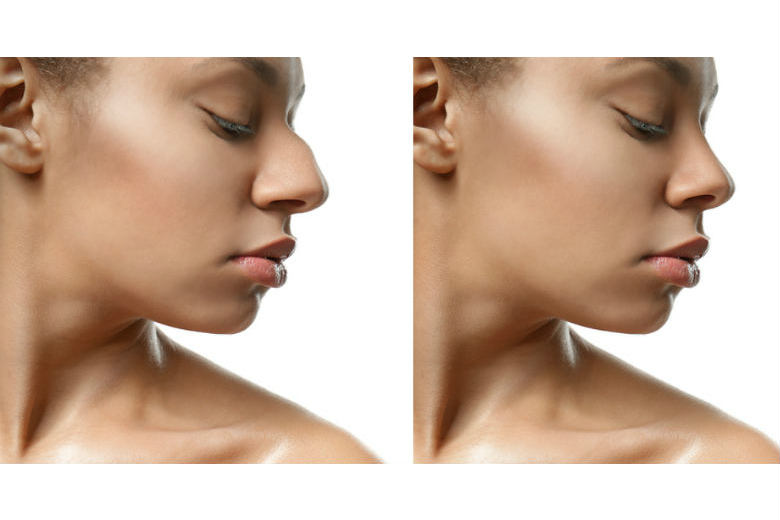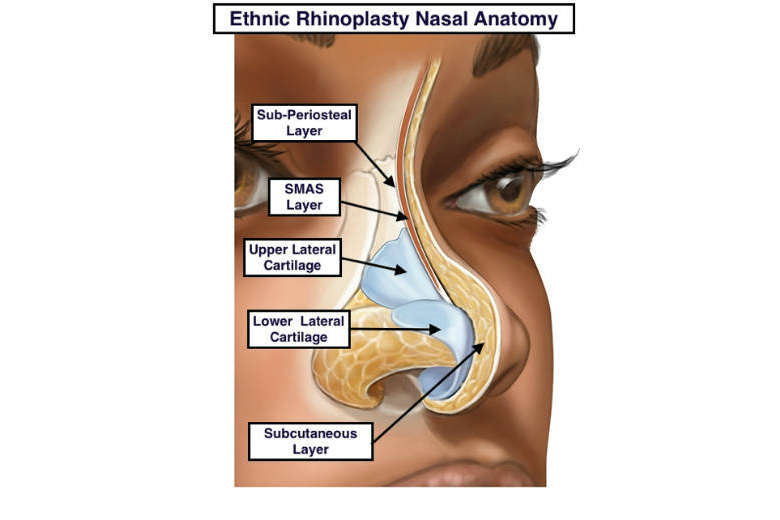Rhinoplasty has been gaining more and more popularity among African Americans over the last three decades. Most individuals undergoing this cosmetic surgery are interested in improving breathing conditions by rectifying the deviated septum or making significant aesthetic changes by getting harmonious noses. It is also essential for the African American population to maintain distinct ethnic characteristics while embracing rhinoplasty evolution. Though no two noses are the same, considering standard nasal features can make the procedure effective while preserving patients’ cultural identity. So, let us discuss everything about African American rhinoplasty in this post. Keep reading.
African American Nasal Anatomy
It is not about short nasal length and thick sebaceous skin for African Americans. Multiple studies have revealed that distinct noses in this population reflect their significantly different skeletal and cartilaginous framework. According to the unique features of the anatomic components, African American noses can be classified into the following three categories: (1)
1. Wide Nasal Ala
Flared ala or overly wide nostrils are the most common concern that used to be addressed earlier through skin excision. However, these days, nostril reshaping gives more natural curves without scars.
2. Wide Nasal Dorsum
A broad, flat, and depressed (low/concave) dorsum or nasal bridge is linked to dorsal irregularities. A cartilage graft from the ear or septum is typically used for bridge augmentation or bone narrowing.
3. Wide Nasal Tip
Sometimes, the nasal tip looks bulbous or less defined with decreased projection. This is rectified by narrowing the bone or reshaping the cartilage present in the lower part of the nose.
Hence, the surgeon must consider the ethnic background and understand the nuances of the patient’s nasal anatomy before planning the surgical procedure.
Also Read – What You Must Know About Cosmetic Surgery Tourism
What Is African American Rhinoplasty?
African American rhinoplasty is a specialized version of rhinoplasty surgery, which focuses on the ethnic features of noses to enhance the natural beauty of African American individuals. Like traditional rhinoplasty, it does not emphasize altering the natural traits of the patient by pinching and turning it up. Instead, this procedure aims to strike a balance between the nose and other facial characteristics to ensure a perfectly natural look. Typically, it is done by tapering the nose bridge, narrowing the nostrils, refining the nose tip, and using implants or harvested cartilage. Though this ethnic rhinoplasty is highly complicated, its outcome is well-defined, well-supported, and well-harmonious.
Reasons For African American Rhinoplasty
The most common reasons for undergoing an African American rhinoplasty include:
- Decreasing the length and width of a broad nose
- Adding more definition to a small nose
- Making a flat nose more projected
- Reshaping flared nostrils for a slimmer look
- Getting an overall balanced look with a symmetrical face
- Achieving better self-confidence with a better facial profile
Ideal Candidates
An ideal candidate for this cosmetic surgery must be 15 years or older, as the nose does not develop fully before this age. She should desire some form of nasal refinement to address specific concerns while maintaining her ethnicity and harmony with the rest of the face.
Also Read – What Is A Facelift? Your Guide To The Age-Reversing Cosmetic Surgery
The Procedure
Though there are similarities in the equipment used and the surgical methods followed, African American rhinoplasty is still very different from standard rhinoplasty, both technically and strategically. Hence, a personalized approach to the surgery is followed based on the patient’s unique nasal features and desires.
There are two choices for the operative technique – open rhinoplasty and endonasal rhinoplasty. In most cases, surgeons stick to the open technique as it offers direct visualization through the incision made in the columella (the bridge of tissue separating the nostrils at the base). The endonasal technique is chosen, and the incision is made inside the nose when there is no need for tip refinement. However, the following are different processes used in African American rhinoplasty :
Alar Base Refinement
When the lateral flaring of the alar base is greater than 2 mm., an alar base resection is performed by keeping the external nasal valve aperture preserved. On the other hand, nostril sill resection and advancement are used to improve the interalar distance.
Nasal Tip Definition
Tip bulbosity is rectified by removing the excess fibro-fatty tissue from the tip of the nose through careful cartilage excision (cephalic trim). Augmentation maneuvers for additional accentuation of the nasal tip, then follow this debulking. Generally, autologous cartilage tip grafts (tip onlay grafts or infratip lobular grafts) are placed through the open approach, and tip sutures (transdomal, interdomal, or intercrural) are used through the endonasal approach. This helps strategically place the grafts onto existing cartilage or into subcutaneous pockets for an enhanced and well-supported tip.
Tip Projection
Structural cartilage grafting helps support and lift the nasal tip. Typically, the septal extension graft or the columellar strut graft is used for adequate projection. However, the columellar strut graft, which is fixed to the nasal spine or left floating freely, is preferred by surgeons for increasing and maintaining tip elevation.
Dorsal Projection
The nasal dorsum is augmented by creating an infracture proportional to the nasal lobule. This, along with interalar width reduction and tip refinement, gives an illusion of slimming down the nasal bridge. Usually, autologous tissue (units of cartilage and bone) or alloplastic materials (silicone, AlloDerm, Gore-Tex, etc.) are used for this purpose.
Surgery Time
African American rhinoplasty can be done in a hospital or an outpatient facility. Both general anesthesia (twilight sedation) and local anesthesia (intravenous sedation) are suitable for this. The surgery usually takes 2-3 hours, with no additional procedure performed.
Post-Surgical Care
In African American rhinoplasty, scars are not visible as they are concealed within the nose or underneath the nasal tip. You will be experiencing swelling and bruising, which will take longer to subside due to the thickness of the skin. Keep your head elevated daily after surgery to reduce excessive swelling and discomfort. Minor bleeding is normal for the first few days. Postoperative pain and nausea are also joint, and your surgeon may recommend painkillers for alleviating it.
There will be a nasal cast to help reduce swelling and bleeding, for which you may find it difficult to breathe through your nose for the first 2-3 days. However, it will be replaced by tape after a week, and you will have to continue it for 6-8 weeks. Make sure that you avoid blowing your nose and all other kinds of trauma during the first week after the surgery.

Before & After – African American Rhinoplasty
Recovery And Downtime
The complete recovery for this specialized rhinoplasty may take 10-14 days. But the side effects start subsidizing a couple of days after the surgery, and you can return to your work within as little as seven days.
Risks And Complications
Like all other cosmetic surgeries, African American rhinoplasty also comes with its risk profile. Some of the most common risks associated with African American rhinoplasty include scarring, keloid formation, prolonged edema, alar base asymmetry, tip necrosis, racial incongruity, etc. Other postoperative complications encountered by patients are excessive bleeding, infection, breathing trouble, anesthetic issues, implant-related problems, pigment abnormalities, revision surgery, and septal perforation.
Also Read – Get Rid Of Ugly Old Scars With Scar Revision Surgery
Cost Of Surgery
The overall cost (including facility fee, anesthesia fee, and surgical fee) for African American rhinoplasty ranges from $3,000 to $8,000 on average.
Dos And Don’ts
Make sure that you follow these preoperative preventive measures to minimize the risk of complications and maximize the outcomes :
- Find a board-certified cosmetic surgeon who specializes in ethnic rhinoplasty and has extensive experience performing African American rhinoplasty.
- Discuss your goals with your surgeon clearly and keep your expectations realistic to help them determine the best operative plan for you.
- Quit the habit of smoking at least one month before undergoing the rhinoplasty.
- Consult your surgeon and stop taking certain medications, including aspirin, anti-inflammatory drugs, herbal supplements, etc.
- Pretreat your skin (bleaching, using Retin-A, microdermabrasion, etc.) anytime between 2 and 6 weeks before the procedure to improve the skin’s quality and reduce the risk of scarring.
Also Read – 26 Most Beautiful Afro Hairstyle Ideas To Try Out
References:
- “Rhinoplasty: The African American Patient,” National Center for Biotechnology Information, U.S. National Library of Medicine


